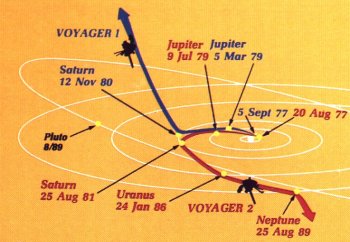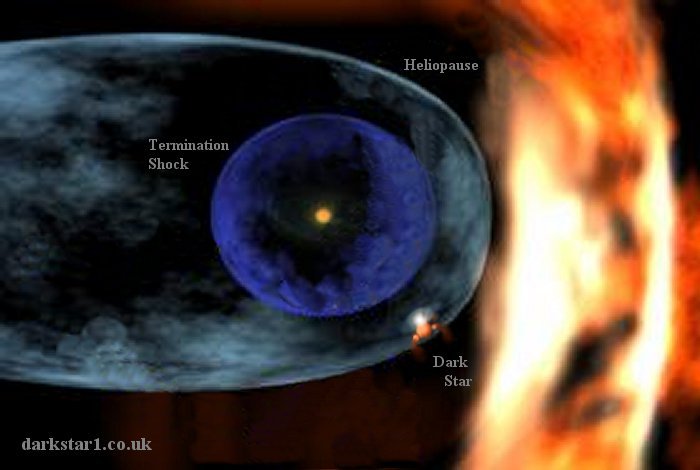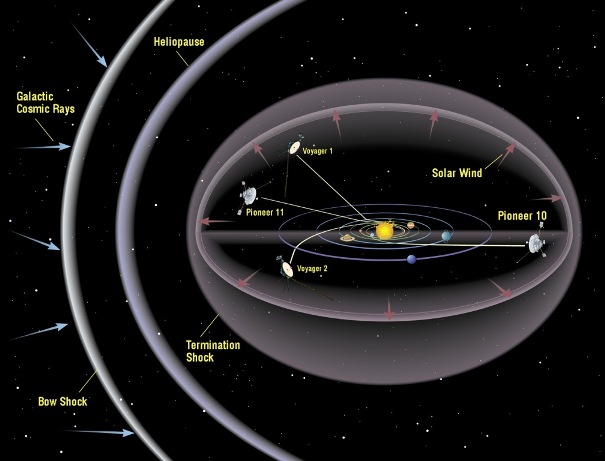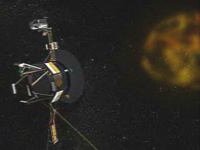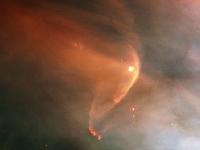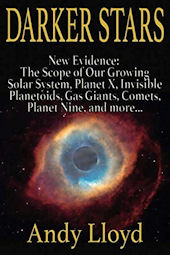The
first hints
about the power of these effects
came from a remarkable image taken by the he Hubble Space
Telescope back in February 1995, shown right. There is a visible bow shock about
half a light-year across which is created as the wind from the star L.L. Orionis
collides with the Orion Nebula flow.
Now, I have written on many
occasions about the elongated path of the Dark Star, a theoretical sub-brown
dwarf which approaches the planetary solar system during its perihelion passage.
This entity is more massive
than Jupiter, and has a strong magnetic field of its own, surpassing that of the
Jovian gas giant. In my forthcoming book, I discuss various scenarios
about how this celestial entity might become visible from Earth, despite
maintaining a vast distance from us. One of those possibilities is that
the Dark Star encounters the regions of space that Voyager 1 is now passing
through. Voyager 1 is detecting great magnetic upheaval here.
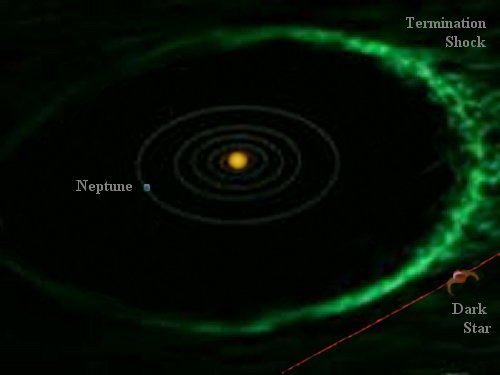
It
seems reasonable to propose that the addition of a sub-brown dwarf into such an
area, complete with its own massive magnetic field, would create vastly more
complex effects. I'm not sure whether those effects would be strong enough
to create an area of luminosity in the magnetic field, like a mind-numbingly
colossal aurora
effect. I'm not sure whether the Dark Star itself would be affected by the Heliopause area
enough to become super-charged, causing it to emit flares of
light. I'm not sure whether these theoretical effects, even if they occur,
would be strong enough to be seen from Earth.
But when you look at that
Hubble image from L.L. Orionis, it makes you pause for thought, doesn't it?
Perhaps this is indeed the mechanism whereby the ancients were able to observe
the Dark Star.
Voyager 2 has reached the edge of the heliopause unexpectedly
early, leading scientists to believe that the heliopause itself is distorted.
It appears to be dented in the southern celestial hemisphere by an unknown
magnetic field. You can read about it at the end of my
Voyager page.
The Dark Star's IBEX Footprint
On 16th October 2009 the latest findings about
the Heliopause interactions were published in the journal Science. This
image, released by the Southwest Research Institute, shows the extent of
interaction of SOMETHING with the Heliopause.
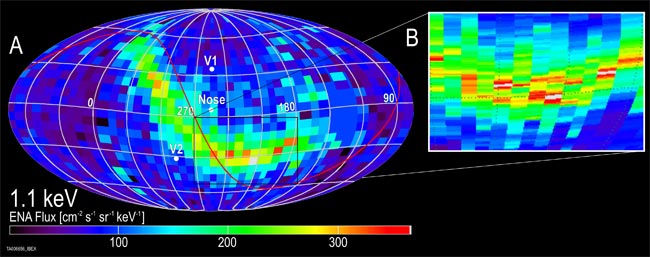
The image is absolutely
incredible, and the anomalous data was so unexpected that the scientists working
on the IBEX project initially thought the data was incorrect. But after
verification, they were left with the grim task of trying to explain an anomaly
that extends across a substantial part of the sky between the Voyager 1 and 2
probes.
"David McComas [IBEX principal investigator at the Southwest
Research Institute] said when he first saw the IBEX results he thought,
"'Something's wrong'...It was quite a long time before we convinced ourselves
that we were right," he said. "[The ribbon is] aligned by and dominated by
the external magnetic field. That's a huge clue as to what's going on. But
still we're missing some really fundamental aspect of the interaction - some
fundamental physics is missing from our understanding."
(4)
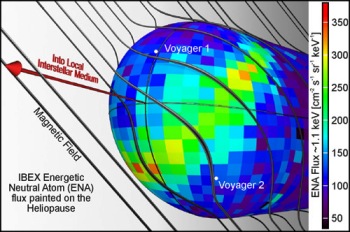
NASA
scientists are trying to grapple with how such an evidently strongly local
interaction could be caused by the galactic fields interacting with the
heliosheath (5). Frankly, I don't think this is the approach they should
be taking at all. The ribbon is running perpendicular to the galactic
field, rather than in line with it. Apart from that, this interaction is
simply too extreme, and was not predicted by theoretical models.
Without the presence of a Dark Star there
simply is no way to explain this emission of anomalous neutral particles from
the Heliopause. It is the simplest and best explanation in town.
I am confident that this new data is extremely strong evidence for the existence
of a sub-brown dwarf beyond the Heliopause in this region of the sky. This
kind of scientific result is exactly the kind of evidence I have been predicting
since my book 'The Dark Star' was released in 2005.
The Dark Star is located beyond the Heliopause,
roughly in the direction of the centre of this ribbon. I think this large
interaction is the Dark Star's extensive magnetic field, and associated particle
bombardment, interacting with the Sun's Heliosheath boundary. The Dark Star's
lateral movement is very slow, so this does not indicate movement, but more like
an aurora effect, like you would see when looking at the Northern Lights.
In 2013, IBEX also revealed the heliotail,
extending away from the Sun in a comet-like manner (6). The structure of
this tail is similar in shape to a four-leaf clover, and rotated slightly due to
external interactions from the local interstellar neighbourhood. Again,
such complexity might allude to the presence of a local phenomenon shaping the
heliotail.
How near, how big?
It's been several years since astronomers discovered a number of
Kuiper Belt Objects with inexplicably bizarre orbits (particularly
Sedna and 2000 CR105).
In my 2005 book 'The Dark Star' I discussed how these anomalies provide evidence
for a companion object located within 2000 Astronomical Units (where one A.U. is
the distance from the Sun to the Earth). At the time, the idea was also
being seriously considered by serious scientists. They performed
calculations to work out what size a companion object would need to be to create
the Kuiper Belt anomalies, and at what distance (7). Their calculations
indicated that a companion object was not only capable of creating these
anomalous orbits, but was theoretically a better fit than the action of a
passing star in the distant past. Here's a section of the conclusion Gomes
et al wrote in their scientific paper:
"We have demonstrated that a distant
planetary-mass solar companion (i.e., a planet orbiting within the inner Oort
cloud) would be capable of raising the perihelia of scattered disk objects and
placing them on orbits similar to those of Sedna and 2000 CR105. The perihelia
of the SDO's are raised by the Kozai mechanism, so the orbit of such a
hypothetical companion would in principle need to be substantially inclined to
that of the orbit of the scattered disk object that was produced by
perturbations of the known planets in order for the type of perturbations that
we are discussing to operate efficiently.
"Note, however, that a very eccentric
Earth-mass companion with small perihelion (60 AU in the example that we
studied) and low inclination could also produce low inclination Sedna-like
orbits. The required minimum
companion mass would be only about Neptune's mass
if it orbited with semi-minor
axis at 2000 AU, but would need to be a Jupiter mass at 5000 AU and 8 Jupiter
masses at 10,000 AU.
"A significant advantage of the solar companion model is that it naturally
produces the very massive inner Oort cloud that is suggested by observations to
date. A brown dwarf's planetesimals captured by the Sun can amount to a large
mass, but the inclination distribution could favor any arbitrary initial plane
(including retrograde)." (8, my emphasis)
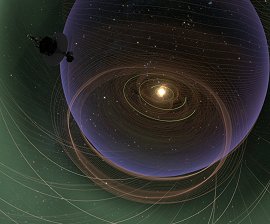
Personally,
I favour a sub-brown dwarf object located in the gap between the Kuiper Belt
(which extends from Neptune out to about 50AU) and the Inner Oort Cloud (from
about 2000AU outwards). The scientists indicate that an object at these
sort of distance would need to be about as massive as Neptune, as a minimum.
That still allows for an eccentric sub-brown dwarf within these parameters.
Such an object would have 'swept out' the area of space between the Belt and the
Cloud.
Interestingly, NASA recently put forward the idea that this same
'space' is currently occupied by part of an interstellar gas cloud, which they
have given the unusual moniker 'Fluff' (9). This proposition is a response
to the finding by the Voyager probes that the Heliopause (the sheath-like border
between the solar wind and interstellar space ~75AU away) is misshapen.
It goes without saying (but I will say it anyway) that a
companion object that has created the Kuiper Belt Object anomalies is also quite
capable of manifesting a huge magnetic field, and of denting the Heliopause.
NASA's ENLIL Program
It's interesting to note that NASA's program to
monitor the heliosphere is known as ENLIL, one of the chief gods of the
Sumerians. Readers of the Dark Star website will be acquainted with the
heliosphere, particularly with regard to the asymmetrical structure of its outer
boundary turned up by the exiting Voyager probes. NASA have put this dent
in the heliosheath down to 'interstellar fluff', where I have argued that the
anomaly may be evidence of the existence of a sub-brown dwarf companion orbiting
the Sun in a highly eccentric orbit. Here's the program's technical blurb:
"ENLIL
is a time-dependent 3D MHD [magnetohydrodynamics] model of the
heliosphere. It solves for plasma mass, momentum and energy density, and
magnetic field, using a Flux-Corrected-Transport (FCT) algorithm. Its inner
radial boundary is located beyond the sonic point, typically at 21.5 or 30 solar
radii ... The outer radial boundary can be adjusted to include planets or
spacecraft of interest (eg 2 AU to include both Earth and Mars, 5 AU to include
Ulysses, 10 AU to include Cassini). It covers 60 degrees north to 60 degrees
south in latitude and 360 degrees in azimuth." (10)
Theoretically, the model could
solve for magnetohydrodynamics calculations right out to the Voyager and
Pioneer spacecraft, assuming they can provide useful data. This would then allow
NASA to model the heliosphere right out to its boundary with interstellar space,
where the interaction of exterior magnetospheres might be measured. This
might include the influence of the interstellar plasma flung outwards from the
galactic core, or of local companions whose own magnetospheres might press
against the Sun's own
shell at its heliopause.
The Sun is a complex MHD system
that is poorly understood, where momentum is passed from the Sun to its planets
through the expulsion of hot solar plasmas, including violent solar flares.
"Previously, theories describing the
formation of the Sun and planets could not explain how the Sun has
99.87% of the mass, yet only 0.54% of the angular momentum in the
solar system. In a closed system such as the cloud of gas and dust
from which the Sun was formed, mass and angular momentum are both
conserved. That conservation would imply that as the mass
concentrated in the center of the cloud to form the Sun, it would
spin up, much like a skater pulling their arms in. The high speed of
rotation predicted by early theories would have flung the proto-Sun
apart before it could have formed. However, magnetohydrodynamic
effects transfer the Sun's angular momentum into the outer solar
system, slowing its rotation." (11)
Any extant
companion sub-brown dwarf would provide substantial angular momentum
to the solar system, filling in the gap that this MHD effect
currently explains away. Bearing in mind how mysterious the
dynamics of the Sun remain, there is certainly room for debate on
this issue (12). Furthermore, given the potential link between the
magnetospheres of the Sun and a proposed massive companion object,
it seems telling indeed that NASA should choose ENLIL as the
program's moniker.
Written by
Andy
Lloyd,
26th May 2005, and updated 24th May 2006, 16th October 2009, 7th
January 2010 and 13th July 2013
author of 'The Dark Star'
(2005), 'Ezekiel One'
(2009), 'The Followers of
Horus' (2010) and 'Darker Stars' (2019)
